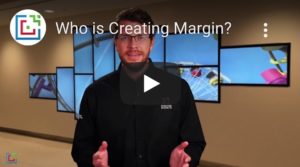The Golden Age of Software (Over)Development
You’ve heard it said that “it’s the golden age of software development”. It truly is. Technologies and their accompanying software tools continue to make our lives easier and our days more productive.
But there is a less discussed side to this golden age of software development. Never have so many software developers employed by competing businesses worked on software tools boasting all the same features. This is particularly evident in our digital signage world. Need a multi-zone presentation? Yep, we can do that. Easy to use software user interface? Sure, we’ve got that nailed. Wayfinding? Yes, we support several ways to do that. Interactivity? I’ll show you how that is done. There are countless digital signage software products out there, and if you set most of them side by side, their capabilities are indistinguishable.
Pricing: A Race to the Bottom
What does this trend of feature parity among digital signage software tools equate to?


First, increasing competition in software pricing: as tools move to feature parity, buyers can more easily drive down prices. The technologies used to update digital signage are basic, and this leaves incumbent products vulnerable to new entrants. The laws of Supply and Demand take hold, and discerning buyers will use the oversupply to their advantage. At Creating Margin, we see this more and more often in competitive situations.
Replaceability: Don’t let the door hit you on the way out


Second, parity among competitive digital signage software feature allows customers to easily jettison their incumbent solution. Sure, like any technology, digital signage software might as well be a foreign language to some people. But for those self-starting technologists out there, learning digital signage software is a relatively painless exercise. From there on, learning a new digital signage software is like getting a new toothbrush – other options might be a different color or a different brand name, but they work the same way. In our ‘what have you done for me lately’ culture, if a customer discovers a soft spot within the Support processes of an organization, a replacement option is only a Google search away. It’s hard to blame the customer for exploring other options, particularly when recurring software fees can appear unnecessary, and in some cases exorbitant (like where an expensive, feature-rich software is never used, and content is not being updated).
Expertise: Focus on Applications, help your Reps do the same


Third, feature parity shines a spotlight on the competencies that organizations have with specific industries. All things being equal, a prospect is even more likely to go with the spokesperson who “speaks the language” of that industry and has the references to prove it. This is an interesting conundrum for digital signage software. In an industry where software products have the same features, why not sell them to any buyer that comes along? It’s tempting to “take every comer” – to try to be everything to everyone – but we must resist this temptation and learn to say no if the fit isn’t obvious. In Polonius’ Advice to Laertes, Shakespeare once said that if you’re true to yourself, you can’t be false to anyone, and decision-makers can likely see through salesmanship to determine if a company is good at what they do.
Creating Margin Creates Content, Not Software


What does it mean to be a software company in this golden age of software development? From what I can tell, many software companies will dedicate themselves to the task of “we are going to try and do every last thing better than the next guy.” Even if this means redeveloping the wheel, companies will hack away at that stone – asking for capital along the way – to create an object that will roll no matter how many companies are on the same path. The more difficult proposition has always been to partner with other companies and to diligently fill gaps, taking incremental steps to build a durable organization.
Providing incredible value by partnering with industry leaders has been key to our success since I founded Creating Margin in 2014. On our About Us page, you can start to learn more about Creating Margin. We have a broad offering across two spaces – workplace management, and digital signage solutions. We always tailor our recommendations to your needs and provide and feature-rich solutions. We’re proud of our partnerships with Pronestor ApS of Denmark and BrightSign LLC of California USA and our own capabilities in content creation, digital signage IT consulting, and training developed over a decade of experience in these industries.
While it’s tempting to get caught up in the excitement of racing other teams in code-a-thons, our approach is instead to develop applications where we can provide unique value, while focusing on our strengths in content creation and professional services.

